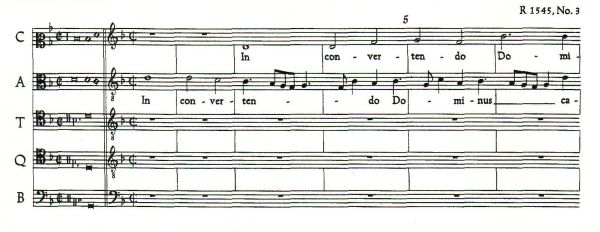De muziek van Cypriaan De Rore
In convertendo Dominus - Converte, Domine
A. Type:
Motet
B. Aantal stemmen:
5vv
Ct. Tekst:
(met vertaling in het Nederlands Engels)
: Lezen
E. Te vinden in de muziekbundel(s):
volgens: Bernstein, Jane A. (1998) :
-
1545 :
{Bernstein} - 52
: 'Rore, Motetta quinque vocum'
volgens: CMME Project(The) - Dumitrescu (e.a.), Theodor :
-
{Census} - ParisBNC 851 ("Bourdeney Manuscript")
: '{Census} - ParisBNC 851 ("Bourdeney Manuscript")'
volgens: Collins Judd, Cristle (2000) :
-
1560, circa ) (source: OwensM) :
{Census} - ModE C.314
: '{Census} - ModE C.314'
volgens: Huys, Bernard (1965) :
-
1553 :
{Huys} - 351_3
: 'PSALMI. Psalmorum selectorum a praestantissimis hujus nostri temporis in arte musica artificbus in harmonias quatuor, quinque, et sex vocum redactorum tomus primus (secundus, tertius, quartus)… - Tomus III (1553)'
volgens: Lewis, Mary S. (1988) :
-
1545 :
{Lewis_1} - 73
: 'RORE. MOTETS A 5'
volgens: Meier, Bernardus (1959) :
-
1545 :
{Meier_I} - R1545
: 'Cipriani Rore Musici Excellentissimi Motetta nunc primum summa diligentia in lumen prodita. Venetiis apud Antonium Gardane. MDXXXXV'
F. Moderne partituur:
See 'Meier, Bernardus : Cipriani Rore Opera Omnia, Vol I : Motets' : p.40
I. Incipit:
 Bron :
'Meier, Bernardus : Cipriani Rore Opera Omnia', American Institute of Musicology
Bron :
'Meier, Bernardus : Cipriani Rore Opera Omnia', American Institute of Musicology
L. Referenties:
Referenties met citaat/commentaar:
1 : Meier, Bernardus,
Cipriani Rore Opera Omnia, Vol I : Motets
(American Institute of Musicology (AIM), 1959)
- p.IV
: 'Semitones too are powerful aids in the portrayal of emotion, as in bars 114-122 of In convertendo Dominus at the words qui seminant in ladirymis. '
2 : Meier, Bernardus,
Cipriani Rore Opera Omnia, Vol I : Motets
(American Institute of Musicology (AIM), 1959)
- p.IV
: 'The introduction of accidentals foreign to the mode often leads to the formation of irregular Phrygian cadences, for instance in bars 130-135 of In convertendo Dominus (Euntes ibant et flebant), bars 45-48 and 100-104 of Plange quasi virgo (et amara calde), bars 55-64 of Quanti mercenarii (pecavi), and bars 102f. of Levavi oculos meos (ab omni malo). Also worth mentioning is the music of the question Quid fecisti? (Domine Deus, bars 65-73): together with two regular cadences on the final G (second mode transposed), there are irregular Phrygian cadences in a and d.
Still more unusal is the setting of the words dolorum meorum in corde meo (Tribularer, si nescirem, bars 72ff.): the Phrygian cadence in a which is, strictly speaking, not allowed in the third mode, is followed by a second cadence on d, still further away from the normal Phrygian closes. In contrast to this, Rore makes use of the Phrygian cadences d, a, and e at the end of the section of the motet O altitudo divitiarum beginning with the words et investigabiles vice eius (bars 33-48). All these cadences deviate from the norm adopted by the second mode transposed, though admittedly the cadence on e is somewhat disguised by the cadential progressions of the Cantus and Bassus.'
3 : Meier, Bernardus,
Cipriani Rore Opera Omnia, Vol I : Motets
(American Institute of Musicology (AIM), 1959)
- p.IV
: 'This use of anabasis is no longer directiy pictorial but has acquired an expressive significance in the setting of the word laetantes (In convertendo Dominus, bars 80-90), coupled as it is with short measures and melismatically arranged text.'
Referenties zonder citaat:
4 : Lowinsky, Edward E.,
Rore's New Year's Gift for Albrecht V of Bavaria
(, 1989)
in : Blackburn, Bonnie J. : Music in he Culture of the Renaissance, and other essays: Edward E. Lowinsky, p. 636-643 (1989)
Pagina laatst bewerkt :
25/10/2023 21:12:01
Eigen code :
#6252 (M_1_40)